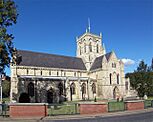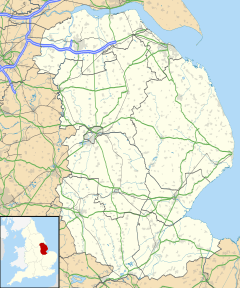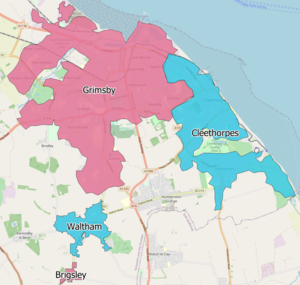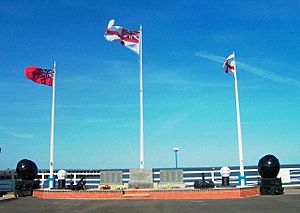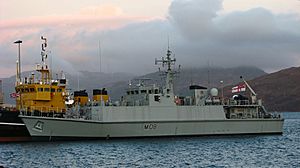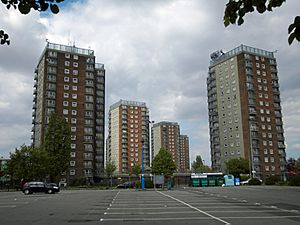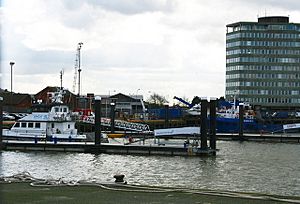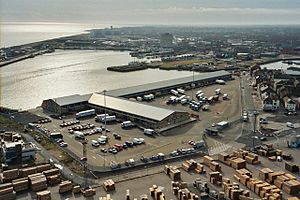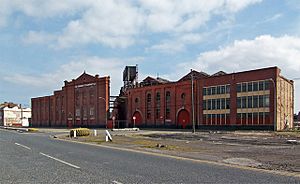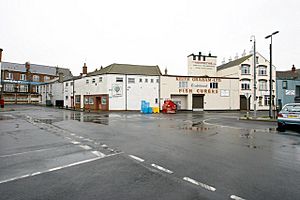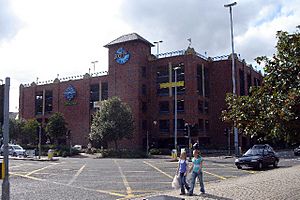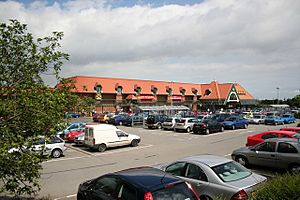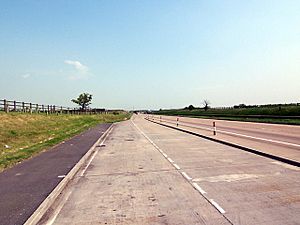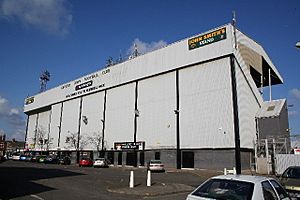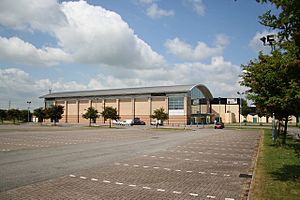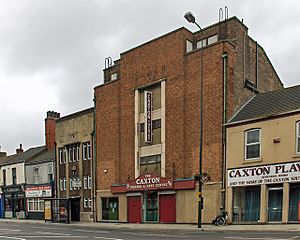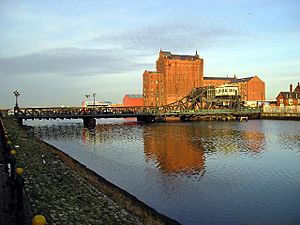Grimsby facts for kids
Quick facts for kids Grimsby |
|
|---|---|
|
|
| Population | 86,138 (2021 Census) |
| Demonym | Grimbarian |
| OS grid reference | TA279087 |
| • London | 140 mi (230 km) S |
| Unitary authority | |
| Ceremonial county | |
| Region | |
| Country | England |
| Sovereign state | United Kingdom |
| Post town | GRIMSBY |
| Postcode district | DN31 – DN34, DN36, DN37, DN41 |
| Dialling code | 01472 |
| Police | Humberside |
| Fire | Humberside |
| Ambulance | East Midlands |
| EU Parliament | Yorkshire and the Humber |
| UK Parliament |
|
Grimsby, also known as Great Grimsby, is a port town located in Lincolnshire, England. It's the main town in North East Lincolnshire. Grimsby is right next to Cleethorpes to the south-east, and together they form a larger urban area. In 2021, about 86,138 people lived in Grimsby.
Grimsby has famous places like Grimsby Minster, the Port of Grimsby, and the Grimsby Fishing Heritage Centre. It was once the biggest fishing port in the world around the mid-1900s. However, the fishing industry later faced big challenges, like the "Cod Wars" and new fishing rules from the European Union. This led to a decline, similar to other industrial towns in the UK.
Since the 1990s, food production has grown in Grimsby. The area, including Cleethorpes, is a key cultural and economic hub for much of northern and eastern Lincolnshire. People from Grimsby are called Grimbarians. Sometimes, they are jokingly called "codheads," especially football fans. Great Grimsby Day is celebrated on January 22nd. Grimsby is the second-largest town in Lincolnshire by population, after Lincoln.
Contents
- Discover Grimsby's Location
- Grimsby's Past: A Journey Through Time
- Understanding Grimsby's Governance
- Grimsby's Economy: Food, Docks, and More
- Learning in Grimsby: Schools and Colleges
- Getting Around Grimsby: Transport Links
- Sports in Grimsby
- Culture and Attractions in Grimsby
- Flood Warnings for Grimsby
- Famous People from Grimsby
- Grimsby's Twin Cities
- Images for kids
- See also
Discover Grimsby's Location
The town was named "Great Grimsby" to tell it apart from Little Grimsby, a village about 14 miles (23 km) south. In 2011, Grimsby had a population of 88,243. It forms a larger urban area with Cleethorpes and nearby villages like Humberston, Scartho, Brigsley, and Waltham. This larger area had a population of 134,160 in 2011, making it the second-largest built-up area in Lincolnshire.
Grimsby's Past: A Journey Through Time
Archaeologists have found signs of a small Roman workers' town in the area from the 2nd century AD. Grimsby's location on The Haven, a waterway flowing into the Humber, made it a safe place for ships during storms. It was also perfect for fishing in the rich North Sea.
Viking Beginnings
Around the 9th century AD, Grimsby was settled by Danes. Local stories say the name Grimsby comes from "Grim," a Danish (or Viking) fisherman. The ending -by means "village" in Old Norse. A medieval story called the Lay of Havelock the Dane tells a legend about Grimsby's founding, but historians consider it a myth.
In Norse mythology, "Grim" is a name used by the god Odin when he travels in disguise. Many English place names in the historical Danelaw (areas settled by Danes) include "Grim," often referring to Odin. Grimsby likely shares this origin.
The Domesday Book of 1086 lists Grimsby as having about 200 people, a priest, a mill, and a ferry.
Medieval Grimsby: A Busy Port
In the 12th century, Grimsby grew into an important fishing and trading port. At one point, it was the twelfth most important town for tax money paid to the King. King John gave the town its official charter in 1201. The first mayor was chosen in 1202.
Grimsby didn't have town walls because it was small and protected by the surrounding marshland. However, the town did dig a defensive ditch.
In medieval times, Grimsby had two main churches: St Mary's and St James. St James, now called Grimsby Minster, is still standing. There's a local folk tale about an imp who caused trouble in the church and was turned to stone by an angel.
By the 15th century, The Haven began to fill with silt, making it hard for ships to dock. This caused Grimsby to decline until the late 1700s. In 1801, Grimsby's population was only 1,524, similar to its size in the Middle Ages.
The Rise of Fishing and Sea Trade
In 1796, the Grimsby Haven Company was formed to improve the town's port. After the Haven was dredged and improved in the early 1800s, Grimsby grew quickly. The port became busy, importing iron, timber, wheat, and other goods. New docks were needed to handle the growth.

In 1848, the railway arrived, making it easier to transport goods to and from the port. Coal from South Yorkshire was sent by rail and exported through Grimsby. Direct train links to London and the Billingsgate Fish Market made fresh "Grimsby fish" famous across the country. The first proper fish dock opened in Grimsby in 1856, making the town key to the fishing industry.
The Dock Tower was finished in 1851, followed by the Royal Dock in 1852. More fish docks and other docks were built over the next few decades. During this time, the fishing fleet grew a lot. Many fishermen from the south-east of England moved north to join the Grimsby fleet.
In 1857, Grimsby had 22 fishing vessels. Six years later, it had 112. The first two steam trawlers built in Britain were based in Grimsby. By 1900, one-tenth of all fish eaten in the United Kingdom was landed here. At its peak in the 1950s, Grimsby was known as the largest fishing port in the world. The town's population grew from 75,000 in 1901 to 92,000 by 1931.
Grimsby During World War II
During the Second World War, the Royal Dock became the UK's largest base for minesweepers in the North Sea. The Navy used many fishing trawlers for this dangerous job. Often, the crews were former fishermen. Minesweepers used special equipment to clear mines from the water. This work was very risky, and many lives were lost. Grimsby's veterans built a memorial by the Dock Tower to remember their brave comrades.
On June 14, 1943, an early morning air raid by the Luftwaffe (German air force) dropped many bombs on Grimsby. This attack killed 99 people. In total, bombing raids during the war killed 196 people in Grimsby and Cleethorpes.
Today, HMS Grimsby is a modern minehunter ship in the Royal Navy.
After World War II: Changes and Challenges
After the "Cod Wars" (disputes over fishing rights with Iceland) and new fishing rules from the European Union, many Grimsby fishing companies stopped operating. This sudden decline ended a way of life that had lasted for generations. Many people lost their jobs and struggled to find new work. Some companies, like the Ross Group, focused on growing other industries in the town, such as food processing.
Grimsby's fishing past is remembered at the Grimsby Fishing Heritage Centre. You can even see a preserved 1950s trawler called Ross Tiger there. While few fishing boats still operate from Grimsby, the town still has an important fish market in Europe.
Grimsby faced challenges in the early 21st century as it moved away from its industrial past. Some areas of the town, like East Marsh, have faced economic difficulties.
Understanding Grimsby's Governance
Since the 2019 general election, Lia Nici (from the Conservative Party) has been the Member of Parliament (MP) for the Great Grimsby area. She took over from Melanie Onn (from the Labour Party), who had been the MP since 2015. This was the first time the Labour Party had lost the seat in 74 years.
| Great Grimsby | |
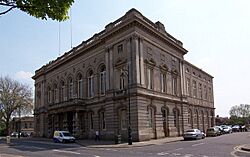 Grimsby Town Hall |
|
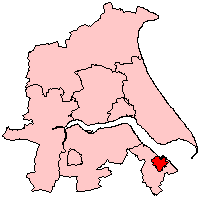 Great Grimsby as a Borough of Humberside |
|
| Geography | |
| Status | Town Charter Granted 1201 Municipal Borough (1835–1889) County Borough (1889–1974) Borough (1974–1996) |
| 1911 area | 2,868 acres (11.61 km2) |
| 1961 area | 5,881 acres (23.80 km2) |
| HQ | Grimsby |
| History | |
| Created | 1835 |
| Abolished | 1996 |
| Succeeded by | North East Lincolnshire |
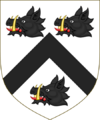 Arms of Great Grimsby Borough Council |
|
Great Grimsby was an old Borough. It was changed by a law in 1835 and became a Municipal Borough. In 1889, it became an independent County Borough, meaning it had its own local government. The Borough grew over time, taking in nearby areas like Clee-with-Weelsby and Scartho. It even had its own police force until 1967.
In 1974, the County Borough was removed, and Grimsby became a non-metropolitan district in the new county of Humberside. In 1979, it was renamed "Great Grimsby."
In 1996, Humberside was abolished. The former Great Grimsby district joined with Cleethorpes to form the new local authority called North East Lincolnshire. The town of Grimsby itself doesn't have its own town council.
Council Wards in Grimsby
North East Lincolnshire Council has eight local areas, or "wards," within Grimsby:
- Freshney Ward
- Heneage Ward
- Scartho Ward
- South Ward
- East Marsh Ward
- Park Ward
- West Marsh Ward
- Yarborough Ward
Grimsby's Economy: Food, Docks, and More
The main parts of Grimsby's economy are its ports and logistics, food processing (especially frozen foods and fish), chemicals, and digital media. Cleethorpes, to the east, is known for tourism. To the west, along the Humber river, there's been a lot of industrial activity since the 1950s, including chemical plants and power stations.
The Food Industry: Europe's Food Town
Grimsby is famous for its connection to the sea fishing industry. At its busiest in the 1950s, it was the largest fishing port in the world. However, the "Cod Wars" and new rules from the European Union caused this industry to decline. In 1970, about 400 trawlers were based in the port, but by 2013, only five remained. Instead, 15 vessels were being used to maintain offshore wind farms.
The town still has the largest fish market in the UK. However, most of the fish sold there now comes by land from other ports or from Iceland in large containers. In 2012, almost 13,000 tonnes of fresh fish sold in Grimsby came from Iceland.
Grimsby is home to about 500 food-related companies, making it one of the biggest groups of such businesses in Europe. For nearly 20 years, the local council has called Grimsby "Europe's Food Town." In 1999, the BBC reported that more pizzas were made here than anywhere else in Europe, even Italy!
Grimsby is known as the main center for fish processing in the UK. About 70% of the UK's fish processing industry is located here. This expertise has helped the town grow into making all kinds of frozen and chilled foods. Companies like Young's Seafood have their main offices here and employ many people.
Traditional Grimsby smoked fish even has a special protected status from the European Union. It's made using a traditional cold smoking process with sawdust in tall chimneys.
The £5.6 million Humber Seafood Institute opened in 2008. It's the first of its kind in the UK and helps support the seafood industry. Grimsby is also a European center for making chilled prepared meals and has Europe's largest number of cold-storage facilities.
Grimsby's Docks: A Hub of Activity
The Port of Grimsby has been used since medieval times. The first enclosed dock was built in the 1790s. The port greatly expanded with the arrival of railways and the building of the Royal Dock, Grimsby in the 1840s. More fish docks were added over the next 80 years. The Kasbah is a historic area near the docks with many traditional fish-processing businesses.
While fishing has decreased, the port is now a major center for importing and exporting cars. Since 1975, it has also handled general cargo. In the early 21st century, it has become a base for maintaining offshore wind farms.
Shopping in Grimsby
Most of Grimsby's main shopping is in the town center, between the railway and the River Freshney. Victoria Street is a pedestrian shopping street, and the Freshney Place center is nearby. Freshney Place gets 14 million shoppers a year and employs over 2,000 people. It has more than 100 stores, including big names like Marks and Spencer.
The center was built between 1967 and 1971 and was originally called the Riverhead Centre. It was later expanded and covered with a glass roof. Two multi-story car parks were also built. This made the old "Top Town" area of Grimsby into a large, covered shopping area.
Other shopping areas include Bethlehem and Osborne Street, which have a mix of shops and services. Many local independent stores are found at the Abbeygate Centre.
Grimsby has two markets: one next to Freshney Place and another on Freeman Street. Freeman Street used to be a very busy shopping area, but it has faced challenges since the late 1970s.
New shopping developments have been built around Grimsby's town center, keeping shopping in a compact area. This makes it easier for people walking or using public transport.
Some larger supermarkets, like Morrisons, Asda, and Tesco, have also expanded in and around the town. The shopping in the area is so good that buses bring shoppers from other towns in Lincolnshire.
Renewable Energy: A Green Future
Grimsby is becoming an important energy center. In 2016, Grimsby produced more electricity from renewable sources like solar, wind, and biomass than anywhere else in England. That year, 28% of its electricity came from green sources. Being close to Europe's largest group of offshore wind farms has created about 1,500 jobs in the area, mostly for maintaining the turbines.
Learning in Grimsby: Schools and Colleges
Grimsby has many primary schools and several secondary schools, including Havelock Academy, Oasis Academy Wintringham, and Ormiston Maritime Academy. Many students from Grimsby also go to secondary schools in nearby towns like Cleethorpes. Private schools in Grimsby include St James' School.
Franklin College is a sixth form college for students after secondary school. The Grimsby Institute offers further and higher education courses, often for specific jobs.
Getting Around Grimsby: Transport Links
Grimsby is about 15 miles (24 km) from the nearest motorway, the M180. The A180 continues into the town, connecting it to the national motorway network. The A18 goes around the town, and the A46 passes through, linking to Lincoln. The A16 connects Grimsby to Louth and other parts of Lincolnshire.
Buses in Grimsby
Bus services in Grimsby are run by Stagecoach in Lincolnshire. They took over from Grimsby-Cleethorpes Transport in 1993. The main bus station in Grimsby is Riverhead Exchange.
Train Travel from Grimsby
Grimsby has train links through Grimsby Town railway station and Grimsby Docks railway station. You can catch direct trains to Manchester Airport via Doncaster and Sheffield. There are also services to Barton-upon-Humber and to Leicester via Lincoln and Nottingham.
Past Tramways
Grimsby used to have two tramway networks. The Grimsby Electric tramway opened in 1912 and connected Grimsby to Immingham until it closed in 1961. The Grimsby Light Railway started with horse-drawn trams in 1881, which were replaced by electric trams in 1901. This system closed in 1937.
Grimsby's Airport
Humberside Airport is about 14 miles (23 km) west of Grimsby. It mostly handles charter holiday flights and is popular for general aviation.
Sports in Grimsby
Football Fun
The local football team is Grimsby Town F.C., nicknamed The Mariners. They play in EFL League Two, which is the fourth level of English football. Their home ground is Blundell Park in Cleethorpes. Grimsby Town is the oldest professional football team in Lincolnshire, formed in 1878.
In the 1930s, Grimsby Town played in the English First Division, which was the top level of football in England at the time. They reached the FA Cup semi-finals twice in the 1930s. In 2010, the team was relegated from the Football League, but they returned in 2016 after winning a play-off final.
Grimsby Borough F.C. is another football club in Grimsby, established in 2003.
Other Sports to Enjoy
An ice hockey club, the Grimsby Red Wings, has been in Grimsby since 1936. They have teams at different levels. In 2009, the club added an ice sled hockey team for people with disabilities.
The amateur Rugby Union team, the Grimsby RUFC, and the Grimsby Town Cricket Club also have good support.
The Grimsby Tennis Centre had major improvements in 2005 and is now fully accessible for disabled people.
Culture and Attractions in Grimsby
Entertainment and Fun
The Barge Inn is a former grain barge that was turned into a pub and restaurant. It has been moored at the Riverhead quay since 1982.
Musical shows and events are held at the Grimsby Auditorium, built in 1995. The smaller
Caxton Theatre is near the docks and hosts plays by adults and young people.
Grimsby's Freeman Street cinema closed in 2004. The Parkway cinema in Cleethorpes now serves the town.
Places to See and Landmarks
- Corporation Bridge
- Fisherman's Memorial
- Grimsby Docks
- Grimsby Dock Tower
- Grimsby Ice Factory – built to make ice for preserving fish
- Grimsby Institute
- Grimsby Minster
- Grimsby Town Hall
- Grimsby Fishing Heritage Centre
- People's Park
- Waltham Windmill
- Weelsby Woods
Grimsby is home to a Blue Cross Animal Hospital, one of only four in the country. It moved to a new building on Nelson Street in 2005.
Media: News and Radio
The local newspaper is the Grimsby Telegraph. Local radio stations include BBC Radio Humberside and Hits Radio Lincolnshire.
Flood Warnings for Grimsby
The Environment Agency has installed flood-warning sirens in Grimsby and Cleethorpes. These sirens are designed to warn about 25,500 homes if there is a serious risk of tidal flooding or if sea defenses might be breached. The sirens can make different sounds, including a traditional wail or a voice message.
Famous People from Grimsby
Many notable people were born or grew up in Grimsby or nearby. Here are a few:
- Shirley Bloomer (born 1934), a tennis player who won French Open titles.
- Richard Buck (born 1986), a sprinter who represented Britain in championships.
- Joanne Clifton (born 1983) and Kevin Clifton (born 1982), professional dancers on the BBC's Strictly Come Dancing.
- Holly Clyburn (born 1991), a professional golfer.
- Quentin Cooper, a BBC Radio 4 presenter.
- Michele Dotrice (born 1948), an actress known for Some Mothers Do 'Ave 'Em.
- Kevin Drinkell (born 1960), a former football player for Grimsby Town.
- Brenda Fisher (1927–2022), a famous cross-Channel swimmer.
- Tony Ford, a footballer who played many games in the English league.
- Freddie Frinton (1909–1968), a comedian and actor.
- Lloyd Griffith (born 1983), a comedian and television presenter.
- Patricia Hodge (born 1946), an actress known for Miranda.
- Guy Martin (born 1981), a motorcycle racer and TV presenter.
- Rod Temperton (1949–2016), a songwriter and producer who wrote hits for Michael Jackson.
- Thomas Turgoose (born 1992), an actor known for This is England.
People with connections to Grimsby:
- Hollie Arnold (born 1994), a Paralympian javelin thrower who won gold.
- Ella Henderson (born 1996), a singer and songwriter who went to school in Grimsby.
- John Hurt (1940–2017), a famous actor who spent his early years in the town.
- Norman Lamont (born 1942), a former government minister, grew up in the town.
Grimsby's Twin Cities
Grimsby has several twin cities around the world:
- Tromsø, Norway (since 1961)
- Bremerhaven, Germany (since 1963)
- Banjul, The Gambia
- Dieppe, France
- Akureyri, Iceland (a friendship agreement was signed in 2007)
Because of its trading ties, Grimsby hosts honorary consulates for Denmark, Iceland, and Norway.
The people of Norway have sent a Christmas tree to Grimsby every year since the end of the Second World War.
Images for kids
-
St James' Church, now Grimsby Minster, before its extension
See also
 In Spanish: Grimsby para niños
In Spanish: Grimsby para niños



